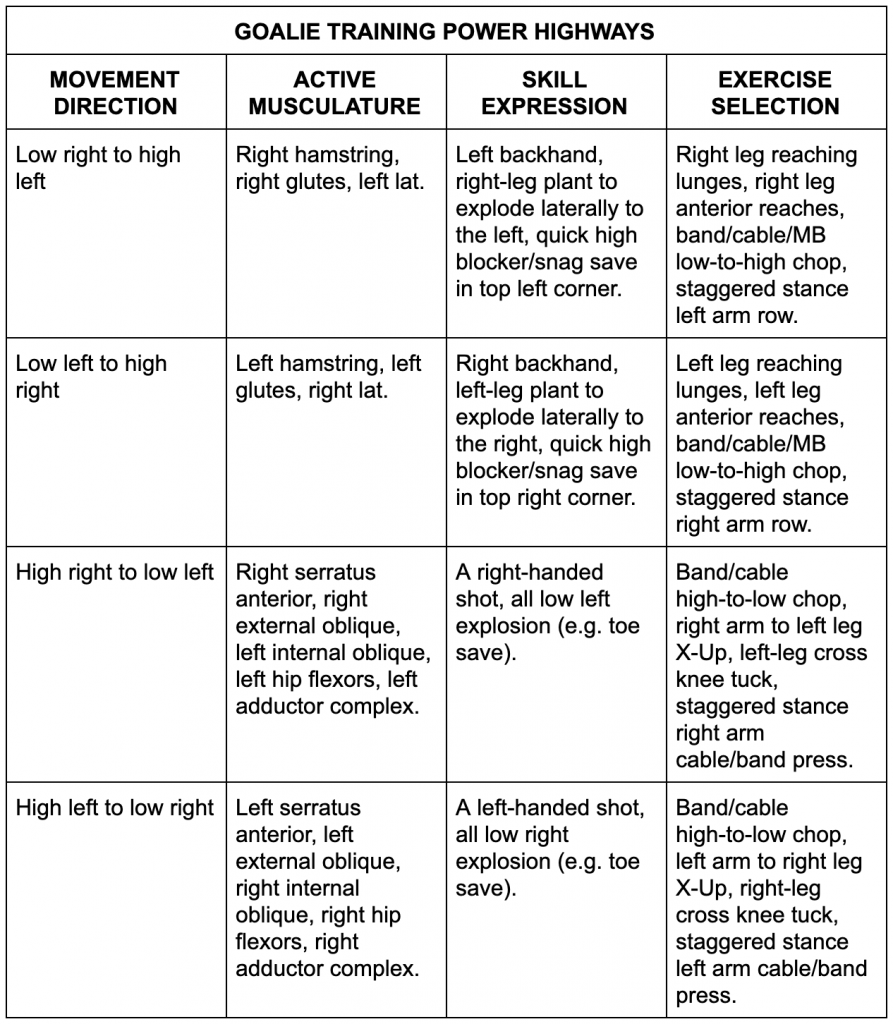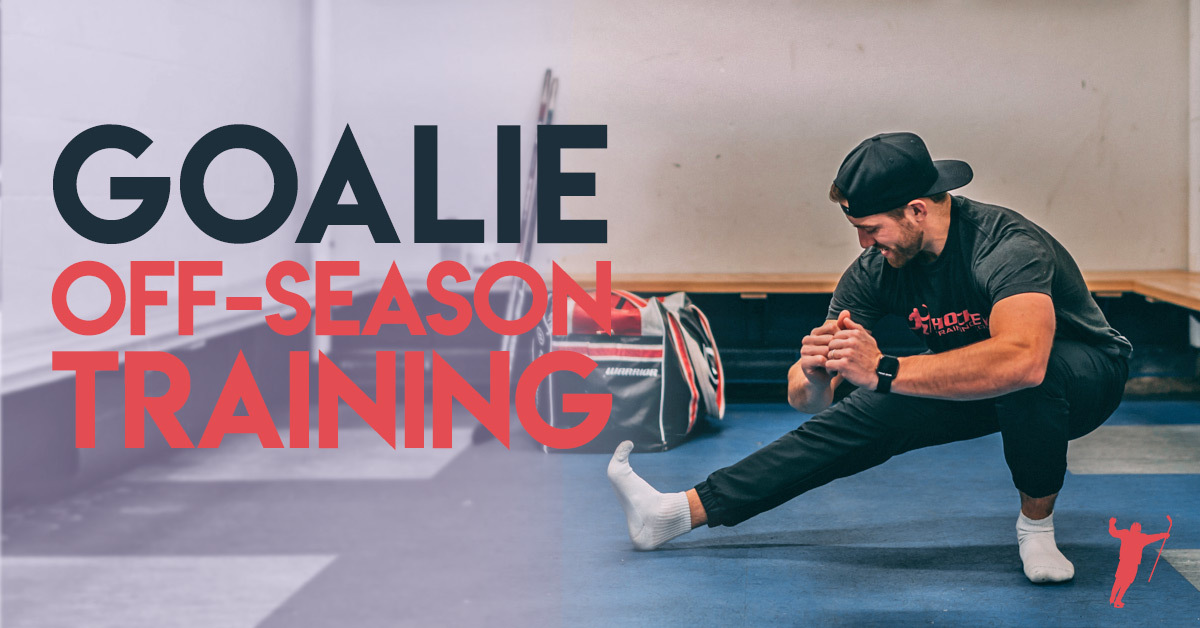In this article, I am going to show you the best way for hockey goalies to train in the off-season so they can see dramatic improvements in their all-around performance.
Goalies need to train differently than their forward/defense counterparts. This should be obvious, but it amazes me how some coaches act as if goalie training is the same as training any other hockey player. From a sports science perspective, this is an oversimplification at best, and completely ignorant at worst.
Would you put a football wide receiver on the same training program as an offensive lineman? Do you think a baseball pitcher improves their ball speed by doing an outfielders program? Of course not! These sports positions and their unique demands are wildly different from one another. The same is true for goalies versus the other players on their team.
It’s important to train goalies appropriately, because they are arguably the most important player on the ice. They are the last line of defense; the degree to which they perform has a massive impact on the outcome of a game.
Because of this, in order to train smart, we need to know what to primarily focus on. For goalies, this means understanding the cross-directional power highways.
Hockey Goalie Power Highways
We have high-to-low power highways located on both the front of the body and the back of the body.
Your front power highways run from each shoulder to the opposing hip; your back highways do the exact same thing but on the back side of the body.
The cross-directional power highways.
Think of an “X” in the front, and then an “X” of identical size and placement on the backs of your shoulders to their opposing glutes.
Both the front and the back power highways work in a coordinated agonist/antagonist pattern—whatever the front accelerates, the back decelerates, and vice versa.
Let’s use the example of snagging the puck on your high right-hand side to illustrate how the power highways work.
From the standing position, the movement is accelerated initially from the lateral power generated in your left leg which will then transfer force in a cross-directional pattern on the back side of your body through your left hamstring, left glute, right lat, and then ultimately into your rhomboid/shoulder girdle.
The back side of your body is creating a cross-directional accelerative effect, and the front side of your body is effectively decelerating so you can maintain proper position and be where the puck is going to be without losing body control (this is done via the left hip flexor/adductor complex, left internal oblique, right external oblique, and right serratus anterior).
Mid-flight during a skater bound with similar posterior accelerators generating power.
Biomechanically speaking, this diagonal acceleration and deceleration is an orchestrated event that is found in all goalie-specific movement training—goalies are constantly moving in a diagonal pattern to all four corners of the net to make big saves.
This movement is also evident in the smaller details: for example, the same musculature that decelerates a goalie’s wrist shot can accelerate the backhand shot.
Solid arrow represents front body acceleration/flexion. Broken line represents the exact same highway on the posterior eccentrically loading (decelerating) to allow explosion on the next stride.
With this understanding, functional training specific to hockey goalies becomes as simple as creating a periodized off-season program that highlights and progresses the power highways in a way that supports the needs of their on-ice movement.
Understanding Goalie-Specific Training
Learning the inner workings of the power highways from a physiological and biomechanical perspective can take a little time, and learning how to train it properly can take even longer.
I’ve created a table to simplify the process and give you some exercises to help you progress during the off-season to become a better goalie.
GOALIE TRAINING POWER HIGHWAYS

What you should be seeking to do with the information above is to create logical progressions from General Physical Preparation (GPP) to Specific Physical Preparation (SPP) across the duration of your off-season so you can peak your goalie-specific skills when it matters most.
Here’s an example bodyweight-only progression of low-to-high lateral power training for goalies across a five-phase program design:
Phase 1: Archer squats
Phase 2: Lateral lunges
Phase 3: Lateral reaching lunges
Phase 4: Skater bounds
Phase 5: Half-kneeling lateral hop
As the off-season progresses, the movement will slowly look more and more like the sport skill you are training, until you reach your “taper and peaking” phase that ultimately unlocks your new level of goalie performance.
How To Dominate Next Season
The above goalie-specific cross-directional strategy for successful off-season hockey training is absolutely critical if you are serious about transforming your performance this year into that of a truly elite goalie.
You can take the information provided within this article and start periodizing your own approach today—but, if you feel like you’re in complete alignment with how I approach the off-season and you’re interested in discovering how I train both the physical and mental performance skills for goalies, then you should check out the brand-new Off-Season Goalie Hockey Training Program.
This is the most advanced off-season hockey goalie training program on the market, and I guarantee that if you commit to following it this year, you will completely change your game on the ice:
- Increase your leg power and explosiveness so you can explode laterally post to post and stop more pucks.
- Improve hand-eye coordination and puck tracking abilities to allow you to stop every puck you can see (thanks to our proprietary Neural Performance Protocols).
- Enhance mobility, flexibility, conditioning, and agility to help you move with ease, injury-proof your body, and get to any puck to make the save.
- Improve your functional goalie strength, coordination, and balance, enabling you to stay positionally sound all game long.
If you want next season to be your best season ever and have coaches, players, and parents in awe of your improvements over the summer, then you need to join the team today.
You can get more details about this “done for you” off-season hockey training program and skyrocket your goalie skills confidence by signing up here.
Final Thoughts
This article has laid out the framework for how functionally specific goalie training can enhance on-ice performance.
From basic definitions to biomechanical discussions of the cross-directional power highways, the information above allows you to better understand goalie-specific training and how to better evaluate your current exercises.
Collectively, this sets the stage for your entire off-season. To learn more about the periodization process, make sure you watch the video below, which I have all new Hockey Goalie Training Members review before starting their off-season program.

